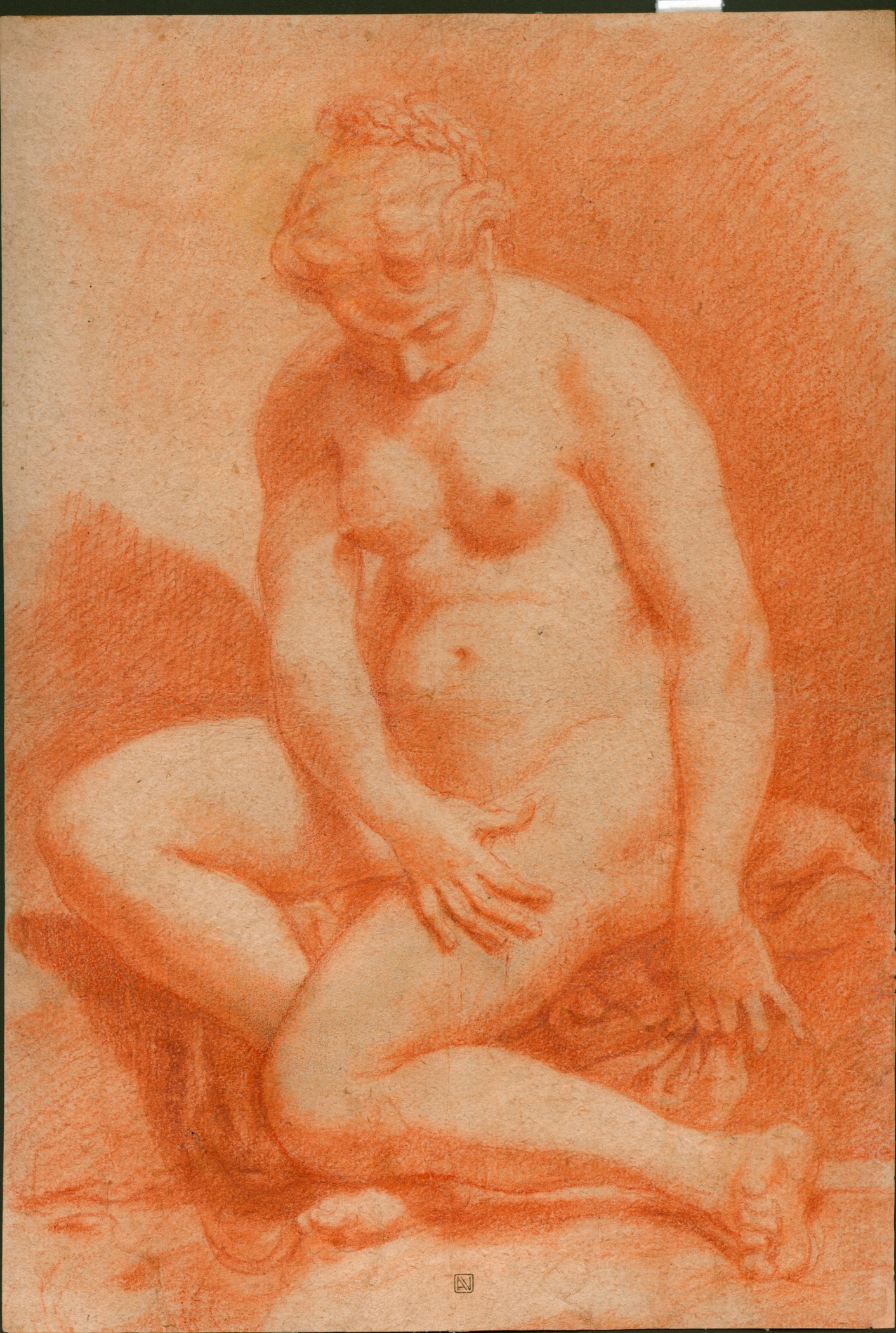Carlo Cignani
(Bologna, 1628 - Forli', 1719)
Diana Bathing, c. 1675
red chalk on paper
425 x 284 mm (16.73 x 11.18 inches)
Carlo Cignani
(Bologna, 1628 - Forli', 1719)
Diana Bathing, c. 1675
red chalk on paper
425 x 284 mm (16.73 x 11.18 inches)
Re: 0264
Provenance: Alfredo Viggiano, (L.191a)
Description:A goddess is shown squatting close to the ground. Modesty prompts her to conceal her nakedness with her right hand, while in her left she clutches the mantle on which she is resting. Her bowed head conveys a sense of intimate meditation, as though our furtive glance had caught the goddess unawares in a moment of solitude.
The subject matter for this fine drawing can be found in Ovid’s tale of Diana and Actaeon (Metamorphoses, III:138-253). The goddess was bathing in a pool – in the drawing, she appears to be on the verge of dipping her foot into the water – when she was surprised by the hunter Actaeon who had the temerity to gaze on her nakedness. To punish the young man’s impudence Diana sprayed him with water, instantly changing him into a stag and causing his hounds to tear him apart. Ovid’s tale was used for centuries as an example of punishment for desire, personified in this instance by the goddess, and thus as an unequivocal allegory of the vanitas, or emptiness, of earthly pleasures.
The drawing offers us a subtle display of the genius of Carlo Cignani, one of the greatest Italian artists of the second half of the 17th century[i]. Born in Bologna and training in the workshop of Francesco Albani, Cignani soon rose to become the greatest exponent of the Emilian tradition of painting. A diligent student of the work of Correggio and of Annibale Carracci, Cignani captured the essence of the Baroque in a manner reflecting the specific spirit of the Bolognese school, while embellishing it with classicising features for which he owed a debt to the work of Guido Reni and his pupils. The drawing under discussion here is easily comparable with one of the masterpieces of Cignani’s graphic output, a Reclining Venus formerly part of the body of the ‘Bonola Codex’ which entered the collections of the National Museum in Warsaw in 1953 (inv. Rys.Ob.d.94)[ii], a preparatory drawing for a composition replicated by the artist in several of his subsequent canvases[iii]. Both the Warsaw drawing and the drawing under discussion here reveal the artist’s matchless skill in the handling of light to produce a soft pastel chiaroscuro that conjures intriguing shadows on the goddess’s neck and bust. Cignani’s ease of expression in this instance points to his early maturity, thus a date some time in the 1670s, shortly before he turned his hand to the frescoes in the Palazzo del Giardino in Parma, would appear to be the most eminently plausible date for this drawing of Diana Bathing.
[i] For the painter, see: S. Vitelli Buscaroli, Carlo Cignani (1628-1719), Bologna 1953; R. Roli, Pittura bolognese 1650-1800. Dal Cignani ai Gandolfi, Bologna 1977, pp. 95-98, 241-243; B. Buscaroli Fabbri, Carlo Cignani. Affreschi, dipinti, disegni, Bologna 1991; D. Benati, M. Solferini, "Maniera grande" e "inarrivabile colorito" in Carlo Cignani, in “Annali della Scuola Normale Superiore di Pisa. Classe di Lettere e Filosofia”, XI, 2019, 1, pp. 95-121, 365-370.
[ii] M. MroziÅÂska, in I disegni del Codice Bonola del Museo di Varsavia, ed. M. MroziÅÂska, exhibition catalogue (Venice, Fondazione Giorgio Cini), Venice 1959, pp. 110-112, n. 94.
[iii] Of the various versions on canvas of the Reclining Venus and Cupids, see in particular that in the collection of the Cassa dei Risparmi di Forlì.

